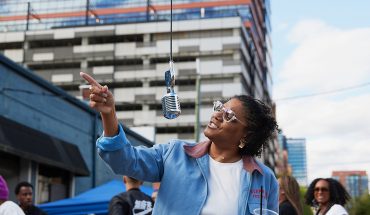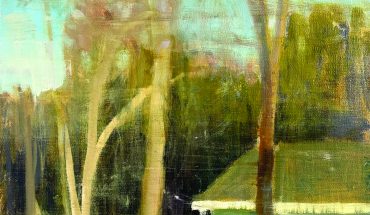by Settle Monroe
The radio never worked and the air conditioning was shot in the 1968 Chevrolet Impala my father inherited from his grandmother. But when I was a 5-year-old girl riding to kindergarten with my dad, its run-down condition was the furthest thing from my mind. I was far more concerned with choosing which song to belt out the window. Dad opted for Neil Young; I remained ever loyal to Carole King. When we pulled into the carpool line of Aldert Root Elementary, he would kiss my cheek before I hopped out of the car. Then I would stand in a billow of black muffler smoke and wave goodbye. Smelling like burnt oil, with my ponytail disheveled from the wind, I would skip to my classroom humming about searching for a heart of gold and feeling the earth move under my feet.
It wasn’t until the fifth grade that I started noticing the other cars in the carpool line, the ones newer and shinier, the ones without duct-taped windows and bumpers propped up with bungee chords. As I neared the end of my elementary school years, I stopped waving goodbye in the black smoke behind my dad’s clunker. Instead I would dart into the building, praying that I hadn’t been seen leaping out. It was then that I started walking to school and gently suggesting that Dad consider purchasing a new car. I was determined to start middle school with a clean emissions grade and a clean slate. But every time I mentioned the idea of new wheels, Dad would cheerfully pat the dashboard of the old Impala three times and say, through a gloriously oblivious smile, “Why would I want another car when I’ve got this baby right here?” At the end of my exaggerated eye roll, I would resign myself yet again to a life of many long walks.
I often think about those adolescent years that were so focused on various objects of desire, with a new family car being desired object No. 1. I remember how I desperately hoped for the day that I would arrive at school in a station wagon … possibly even a minivan. Looking back, it all seems pretty silly and insignificant. It is easy to dismiss such childish hopes. But then again, we are all developing and changing, striving to become better versions of ourselves. We are always growing in our desires and longings. And hope may look very different at different points in our lives.
We hear a lot about hope these days, on the screen of the television and in the verse of musicians. We read about hope in the poet’s carefully crafted stanza, or while sitting in traffic and staring at the bumper sticker in front of us. It seems that hope is all around us. And yet hope is just a concept until it can truly be seen in the day-to-day, walking-around life. Like many of the great human virtues, hope is just an idea until it puts on skin. I see hope most powerfully in people, ordinary people, who are living with a deep desire for change woven into their days.
I see hope in the community of neighbors who meet together month after month to discuss, plan and strategize effective ways to combat crime in their streets, believing that they can do better. I see hope in the fourth-grade girl who comes to the nonprofit center downtown every Tuesday evening to be mentored and tutored, stumbling through challenging chapter books and scratching out numbers in long-division problems. She knows that she is her own best bet for improving her future. I see hope in the elderly man who walks up and down his sidewalk day after day, clutching his cane and shuffling his feet. He refuses to settle for stationary and trusts that taking care of his aging body will soften the pain and increase the joy of his final years. I see hope in the mother who doles out discipline and grace to her teenager every waking minute of the sometimes-endless day. She is convinced that this hard sowing will one day yield beautiful fruit.
Hope is found in each of us who is putting one foot in front of the other, walking or crawling towards something better, not stopping when hope is deferred. Even when crime continues in the neighborhood, when the elderly man can no longer stroll and when the teenager turns from his mother: Hope is not gone. For the power of hope does not live in a desired outcome. Hope is spurred by the change occurring within us.
Nelson Mandela wrote, “The greatest glory in living lies not in never falling, but in rising every time we fall.” Perhaps hope looks like rising and stepping. Maybe hope looks like people taking small actions for a better life and hoping for a greater change within. To hope, we have to actually walk through the muck of the daily grind. Though circumstances may not appear to change, by carrying hope, we are becoming better. Not only do we hope for change, we change by hoping.
It was years after elementary school when the Chevy Impala finally clunked to its final stop. I watched through the front window of our house as Dad handed over his keys to an antique car collector in exchange for $250. Dad shrugged his shoulders as he walked into the house and asked if I was ready to start shopping for a new car. It was finally the moment I had hoped for; at last I might ride to school in some sort of style. But in that moment, all I wanted was to chase down the tow truck with our old, beat-up car chained to its ramp.
It was then that I realized that I had been changed in those years of riding and waiting. I realized that even in a little girl, hope digs deep and brings up something or someone new. For suddenly it didn’t matter much to me which car we brought home from the dealership. Those early mornings of enduring adolescent embarrassment had slowly chipped away at my insecurity and desire to blend in with my minivan-riding friends. In fact, I had even begun to appreciate uniqueness and individuality as powerful qualities not just in a car but also in a person’s character.
I know that a young girl hoping for a new car is not comparable to the hard work that so many are doing to bring about real change, by spreading compassion and empathy, all pointing to a greater good. I know that people are fighting good fights by tirelessly working to implement positive changes in government and schools, communities and neighborhoods. But I also know that the old Impala taught me about hope. It taught me that sometimes there is nothing glamorous about it, that hope can shine through the ordinary. Most importantly, the jerry-rigged bumper and the patched-up windows of Dad’s Impala showed me that the growth happening within us is just as valuable as the outcomes we so fervently chase.




